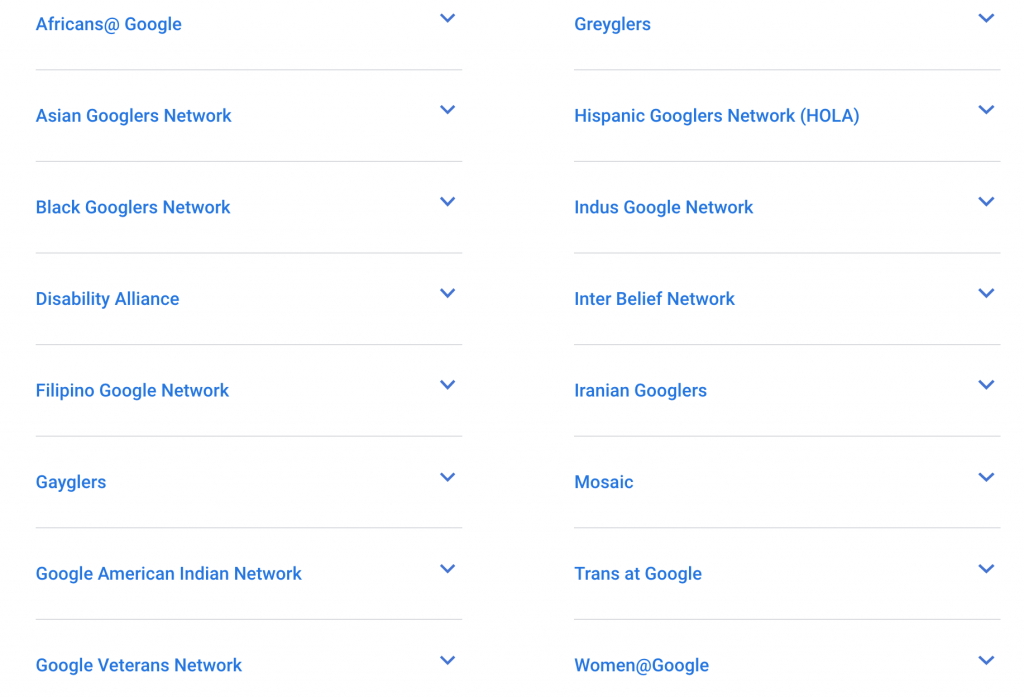- 16 Helpful Career Site Self-Service Tools for You - December 18, 2025
- Last Week I Had a Viral LinkedIn Post — But Why? (And What TA Folks Can Learn From It) - December 8, 2025
- Job Description Process Improvement: How One Workflow Fix Saved 1,200 JDs from Chaos - December 4, 2025
Top companies are talking about Diversity & Inclusion in the wake of the Black Lives Matter movement. But how do you implement a diversity and inclusion strategy?
Developing an effective strategy for managing diversity starts with a conversation and is followed by action. Here are 7 steps we found for implementing a diversity strategy for your organization.
So, the steps below assume that you’ve already dedicated a team member to own your D&I strategy. This would normally be either a head of diversity such as a Chief Diversity & Inclusion Officer (see The Top 20 Diversity Titles [with Descriptions] for examples of titles this person might hold).
If you’re not ready to have C-Suite head of diversity, some companies will start with dedicating a more junior role for diversity. Swisher International, for example, recently named an employee their Manager of Inclusion, Diversity & Transformation.
1. Do a full diversity audit
What is a diversity audit? A diversity audit includes looking at a company and its workforce as a whole and analyzing the percentage of underrepresented groups (like people of color and women). Diversity audits also look at the representation of diverse individuals in senior-level management positions or the board of directors.
Analyzing compensation for employees and reviewing company vendors are also important steps during a diversity audit. If there are salary gaps based on employees’ race or gender, this is important to note. And if there is little vendor diversity, this should be addressed in the corporate diversity strategy. Torin Ellis, a diversity strategist who has consulted with Nike recently told the Wall Street Journal:
“You have to really be able to look out over your organization and say: Where are we? Like, where are we really as a company?”.
Nike has been a champion for diversity of all types (race, gender, sexual orientation, age, etc.) and has won awards based on the foundation of a diversity audit:
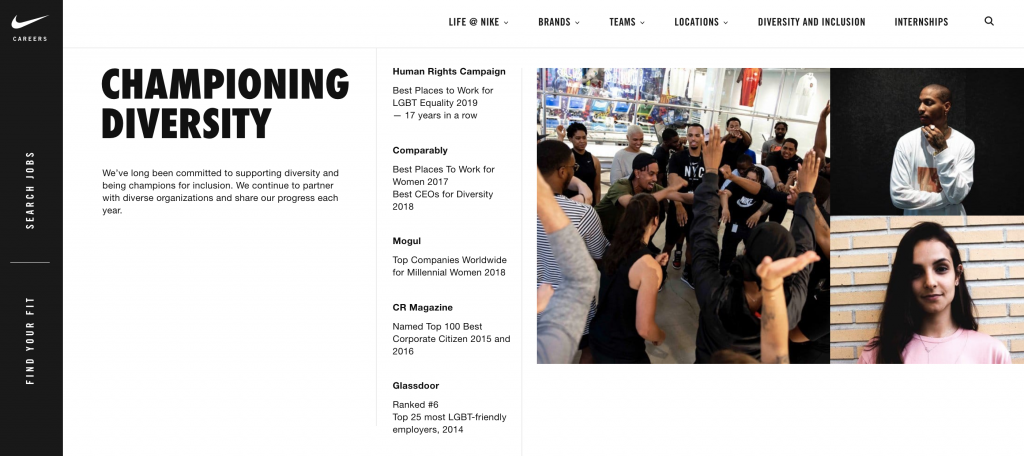
SHRM said in a recent blog:
“Employers must first know what their workforce looks like compared with the labor market. By capturing data on employee demographics, an employer is better able to understand the diversity of its employees and identify any areas of concern or trends.”
So, this further solidifies the need to conduct a diversity audit as the first step in implementing an inclusion strategy. A diversity audit should including these items:
- Collecting demographic data through traditional HR tools
- Surveying employees regarding diversity & inclusion topics
- Conducting personality tests of the workforce
- Analyzing HR & survey data for trends
- Identifying areas of concern
2. Release a diversity report
Part of the strategy for managing diversity includes being transparent. The next step after a diversity audit is to publicly release a diversity report with findings from the audit. A diversity report includes data on the number of women and people of color employed company-wide, including leadership roles.
Apple’s diversity report shows they are making progress:
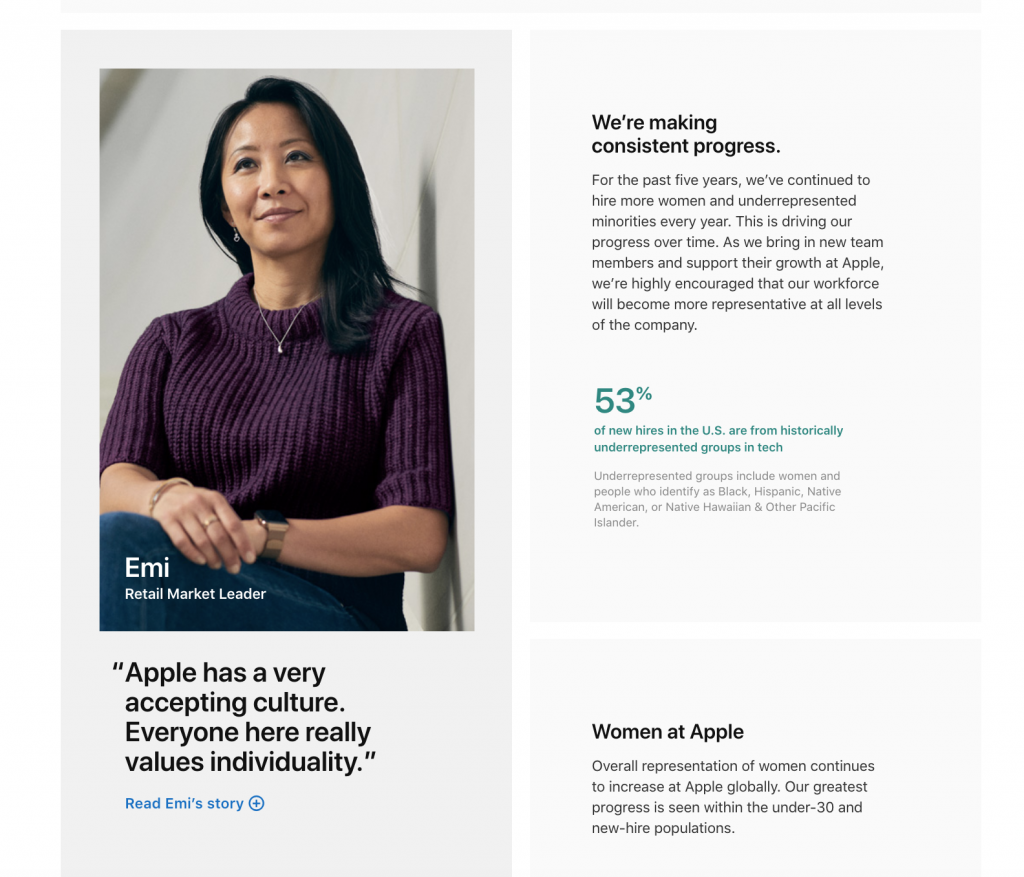
Google’s 2020 diversity report shows a comparison of hires from last year based on race and gender:
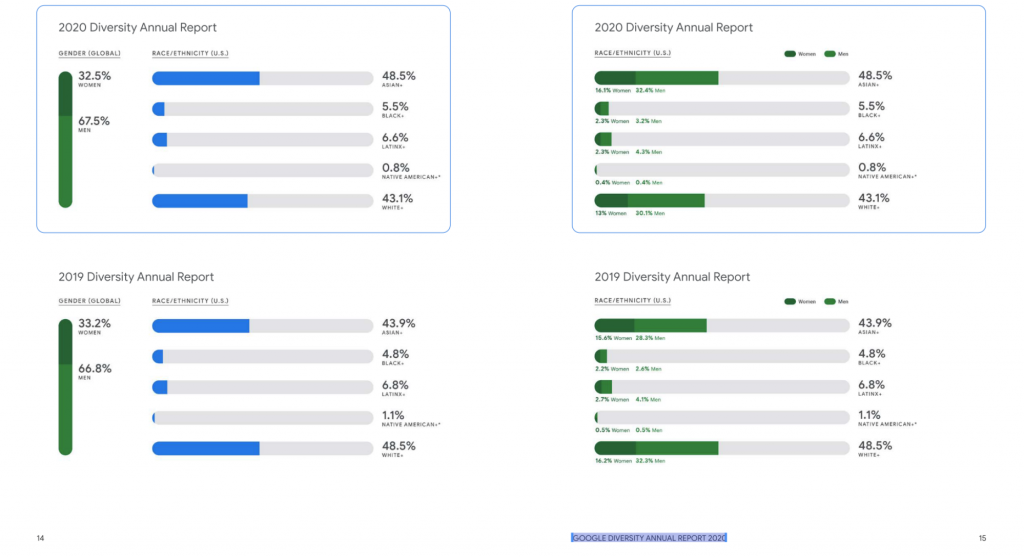
A diversity report helps organizations create goals and targets to improve their diversity and inclusion strategy. The diversity report is the foundation and marker for improving diversity and setting inclusion strategy goals.
3. Commit to exact diversity goals/targets
After seeing the diversity numbers on paper (or on-screen) using those numbers to commit to diversity goals is the next step. We recently found some examples from top companies who have set diversity strategy goals and listed them in our article, 22 Examples of Awesome Diversity Goals.
So, diversity goals should be both short and long term. Allow yourself ample time to improve. Gabrielle Shirdan, a VP/Creative Director at a NY-based advertising agency said in the Wall Street Journal:
“Everyone is trying to solve for years of systematic racism in a press release in four minutes.”
Setting goals with a reachable target is key. Google’s parent company Alphabet, Inc. is dedicated to increasing the proportion of “leadership representation of underrepresented groups” overall by 30% at the company by 2025. Setting a time frame keeps companies on track and accountable.
Some examples of diversity goals include:
- Working with Black-owned businesses (AT&T)
- Individual employees setting diversity goals (Expedia)
- Increasing diversity in leadership (Facebook)
- Creating an Inclusion & Diversity Advisory Board (GM)
- Increasing bring from underrepresented communities (Intel)
Other diversity and inclusion goals include training for employees and executives to increase visibility and understanding of diverse colleagues. One program called CEO Action has 1,000+ CEOs and Presidents who have pledged to support a more inclusive workplace. Companies like Uber even incentivize leadership to be diverse. The Financial Times reported that Uber factors in diversity targets when bonuses are calculated for top executives.
Other companies tying diversity goals to bonuses according to Payscale:
- Johnson & Johnson
- Microsoft
Some companies also push for diversity in their partners/suppliers.
For example, at Microsoft, law firms can earn back 3% of their fees as a bonus if they hit diversity targets. Intel will hire only U.S. equity partnerships made up of at least 21% women and 10% underrepresented minorities.
4. Establish a Diversity & Inclusion Council
Bringing together a group of people who champion diversity within a company is another step towards implementing a diversity and inclusion strategy. Once goals and targets are set, a diversity board can work with senior management to keep diversity efforts on track. Antonio Neri, CEO of Hewlett Packard Enterprise recently posted a blog about the creation of their diversity council. He said:
“We will launch a global HPE Inclusion and Diversity Council. The council will include team members from across our businesses and functions representing all facets of diversity, and I will chair this council. The council will oversee the development of a detailed plan and ensure we’re all collectively held accountable to meet our goals.”
A D&I council, not only keeps a company accountable for their diversity goals but also promotes the company’s diversity statement. We listed some top companies with strong diversity statements in our article, 10 Examples of Awesome Diversity Statements.
5. Dedicate funds to diversity-minded Employee Resource Groups
Another step towards creating a strategy for managing diversity is to dedicate funds to diversity-minded resource groups both internal and external. Employee resource groups (ERG’s) are able to bring in speakers to talk about important diversity and inclusion topics. S&P Global supports 9 ERG’s to support the acquisition, engagement, and development of diverse talent.
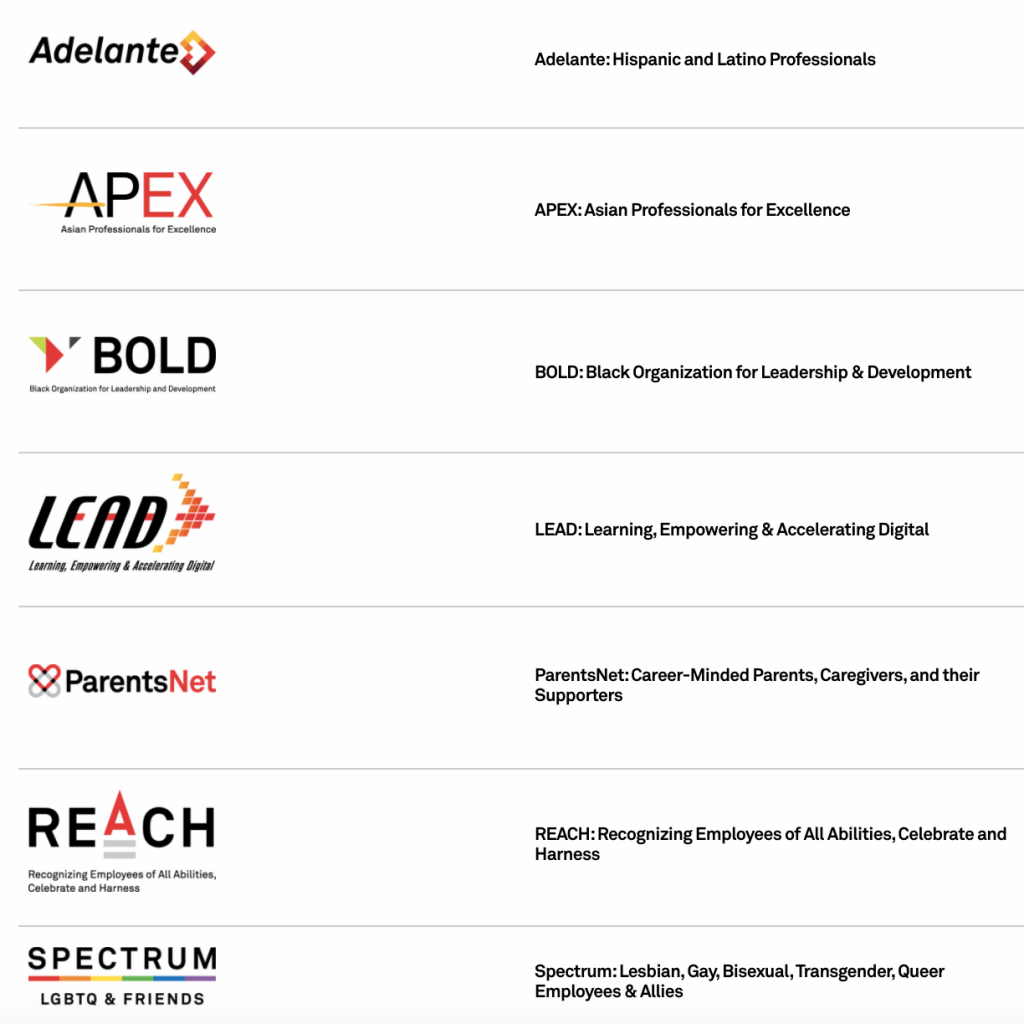
Google has 16 ERG’s with more than 250 chapters globally that support professional development opportunities for underrepresented communities.
Along with supporting employee internal employee resource groups, many top companies recently committed to investing sizable cash money in good D&I causes. Some examples of these diversity strategy goals are:
- Adidas committing $120 million to causes related to ending racial injustice between now and 2025
- Apple committed $100 million to the Racial Equity and Justice Initiative
- Microsoft adding $150 million to its diversity and inclusion investment (the Microsoft diversity strategy also includes promoting cultural awareness through over 50 employee community groups)
- Netflix putting 2% of its cash holdings, or up to $100 million initially, toward financial institutions and other groups that directly support Black communities in the U.S.
6. Standardize hiring
Establishing a diversity hiring strategy and standardizing the hiring process is a crucial step in creating a diverse and inclusive work environment. All candidates should be measured by the same scorecard and bias should be removed from all aspects of the hiring process to ensure candidates are on a level playing field. Our recent article on 5 Examples of Racial Bias in Hiring touches on this. here are a few ways to standardize hiring:
- Removing unconscious bias from job descriptions (proud plug: Ongig’s Text Analyzer Tool can do this!)
- Making decisions based on candidate’s qualifications, not their name, during screening.
- Asking the same interview questions for all candidates, and hiring based on their answers, not their physical appearance or accent.
All 6 of these steps are important in implementing a diversity and inclusion strategy for your company. According to a report from McKinsey & Company, building a diverse workforce even gives companies an edge over competitors.
7. Review & share an update
Once a diversity and inclusion strategy has been implemented, it doesn’t mean that a company should stop there. D&I is an ever-changing space, so companies should stay active by continuously reviewing improving strategies. To do this companies should:
- Compare diversity data pre and post strategy launch
- Measure the results of diversity goals and targets
- Keep the Diversity Council active
- Look for new ERG’s based on hiring new underrepresented groups
On top of the items listed above, sharing results with the public whether it be through a blog or a formal diversity report on a company’s website, sharing growth and changes is important. Doing this will highlight improvements and also areas where changes in the right direction can still be made.
[D&I Strategy Tips Update September 1, 2020]
After I wrote this article, PwC came out with a great diversity report PDF in which they outlined the steps they took to implement a diversity and inclusion strategy. The report is chock full of ideas.
In one section, they share their steps to implement a D&I strategy and I thought I’d share it here:
- analyze the data
- identify root causes
- define our approach
- apply our values
- test and measure the rate of change
- hold ourselves accountable
Bonus tips for your diversity and inclusion strategy
Invest in internships for people of color
Ongig client Peak6 partners with the Greenwood project to create financial internships for people of color.
“Greenwood Project introduces Black and Latinx students to careers within the financial industry via paid summer internships, educational field trips and our summer financial institute for high school students. In many cases, our programming gives young people strong motivation to succeed in their remaining high school tenure and also a compelling reason to attend college.” (source: https://greenwoodproject.org/about/)
The initiative is growing each year. More firms are coming on board leading to more opportunities for students of color to get involved.

Xbox Publishing is another organization that sponsors technology training for young people of color and from low-income backgrounds through a program called Gameheads.
Celebrate more holidays and events
Companies are adding special events around inclusion as a part of their diversity strategy. For example, Rogers Communications keeps an:
“open dialogue on racism at two events hosted by our Black Leadership Council, Rogers Mosaic, and Rogers Women of Colour.”
Rogers also celebrates Lunar New Year, Black History Month, and International Women’s Day with events and content across their various platforms to promote diversity.
How do you know if your D&I strategies are working?
You’ve implemented your D&I strategies in your company, but how do you know it’s working? Here are a few key performance indicators that’ll tell you how effective your strategies are.
- Recruitment figures. One of the easiest ways to measure your D&I strategies’ success is to look at the demographics of your applicants. Are you receiving applications from people from diverse backgrounds (race, gender, age, etc.), or are they heterogeneous?
- Percentage of leadership roles in diverse backgrounds. Another good indicator of D&I’s success is looking at the people in leadership positions. Are the people in leadership positions coming from diverse backgrounds? How long does it take for these people to get to their current positions?
- Employee Retention. A good indicator of D&I’s success is looking at how long people from diverse backgrounds stay. If these people remain in the company, they are happy and see opportunities in the company.
What does workplace diversity and inclusion entail?
Diversity and inclusion aren’t just buzzwords thrown around in the corporate world—they’re fundamental pillars shaping the way we work together. So, what exactly do we mean when we talk about workplace diversity and inclusion?
First off, let’s break it down. Workplace diversity means having a team made up of people from all kinds of backgrounds: different races, genders, ethnicities, and more.
Now, let’s talk about inclusion. It’s not just enough to have a diverse team; you’ve got to make sure everyone feels like they belong and that their voices are heard. So, inclusion is about creating an environment where everyone feels valued, respected, and supported, no matter their differences.
When we say diversity and inclusion, we’re talking about creating a workplace where people feel safe to be themselves. It’s about fostering a culture where everyone’s ideas are welcome, and everyone has an equal chance to succeed.
But why is this important?
Well, for starters, diverse teams are more innovative. So, when you bring together people with different perspectives and life experiences, you open the door to new ways of thinking and problem-solving. Also, studies have shown that companies with diverse teams perform better financially. So, not only is it the right thing to do—it’s also good for the bottom line.
In addition, creating a diverse and inclusive workplace doesn’t happen overnight. It takes time, effort, and commitment from everyone—from senior leaders to frontline employees. So, it means setting specific goals, implementing inclusion initiatives, and regularly checking in to see how we’re doing.
One way we can measure our progress is through anonymous surveys. By giving everyone a chance to share their thoughts and experiences anonymously, we can get a better sense of where we’re doing well and where we need to improve.
But it’s not just about numbers and metrics. It’s also about creating a culture where everyone feels like they belong—a culture where diversity and inclusion are part of our company’s core values.
We can’t talk about diversity and inclusion without addressing unconscious bias. We all have biases, whether we realize it or not. But by undergoing unconscious bias training, we can learn to recognize and challenge our biases, creating a more fair and inclusive workplace for everyone.
Why is workplace inclusion important?
Well, let’s start with the basics. Workplace inclusion is about making sure that everyone feels like they belong, no matter who they are or where they come from. So, it’s about creating a safe space where people can bring their whole selves to work without fear of judgment or discrimination.
But it’s not just about being nice—it’s also about being smart. Research has shown that companies with inclusive cultures are more successful. That’s because when you create an environment where everyone feels valued and respected, you also create a space where people are more engaged, more productive, and more innovative.
Think about it: when people feel like they belong, they’re more likely to speak up, share their ideas, and collaborate with others. Also, when you have diverse teams working together, you’re more likely to come up with new ways of doing things and solving problems.
But workplace inclusion isn’t just good for business—it’s also the right thing to do. It’s about treating people fairly and giving everyone an equal opportunity to succeed, regardless of their background or identity. It’s about creating a culture where everyone’s voices are heard and everyone’s contributions are valued.
And let’s not forget about the bottom line.
Studies have shown that companies with diverse teams are more profitable. That’s because when you have people from different backgrounds and perspectives working together, you’re better able to understand your customers and meet their needs.
So, whether you’re a CEO or an entry-level employee, workplace inclusion should be a top priority. It’s not just a nice-to-have—it’s essential for building a company culture where everyone can thrive.
And the best part? Creating an inclusive workplace doesn’t have to be complicated. So, it can start with small steps, like implementing inclusive hiring practices or offering unconscious bias training. Take these steps to create a workplace where everyone feels valued, respected, and empowered to be their best selves. And that’s something worth striving for, every single day.
How to improve diversity and inclusion in the workplace
Firstly, it starts with senior leaders and the executive team. They need to make a strong commitment to diversity and inclusion by incorporating it into the company’s core values and business goals. When leaders set the tone from the top, it sends a powerful message that diversity and inclusion are essential components of our company culture.
Next, it’s important to set specific goals and develop an inclusion plan. By outlining clear objectives and strategies, we can hold ourselves accountable and measure our progress over time. So, these goals could include increasing ethnic diversity in leadership positions or implementing unconscious bias training for all employees.
In addition to setting goals, we need to take concrete actions to promote diversity and inclusion. This could involve implementing inclusive hiring practices, such as using anonymized resumes to reduce unconscious bias or creating employee resource groups for different minority groups.
Another effective strategy is to foster an inclusive environment where everyone feels like they belong. So, this means creating a safe space where people can share their ideas and perspectives without fear of judgment. It also means promoting diversity of thought by encouraging employees to consider different perspectives and challenge their own biases.
Employee engagement in your diversity and inclusion strategy
Furthermore, companies can leverage their employee engagement initiatives to promote diversity and inclusion. This could involve hosting workshops or training sessions on diversity and inclusion topics, or creating opportunities for employees to get involved in diversity-related initiatives.
Moreover, companies should regularly collect feedback from employees through anonymous surveys to identify areas for improvement and measure the effectiveness of diversity and inclusion efforts. So, this feedback can help us understand how employees from different backgrounds experience the workplace and identify any barriers to inclusion that may exist.
Lastly, it’s important to remember that improving diversity and inclusion is an ongoing process. It’s also crucial to engage employees in the diversity and inclusion strategy. This means involving everyone from senior leaders to frontline employees in the process. By continuously striving to create a more diverse and inclusive workplace, we can build a company culture where everyone feels valued, respected, and empowered to be their authentic selves.
Diversity and inclusion workplace benefits
First and foremost, having diverse teams is like having a secret weapon. When you bring together people from different backgrounds, ethnicities, genders, and experiences, you create a melting pot of ideas and perspectives. This diversity of thought sparks creativity and innovation, leading to new ways of solving problems and driving business growth.
Moreover, diversity and inclusion are essential ingredients for building a strong company culture. When employees feel like they belong and are treated fairly, they become more engaged and committed to their work. So, this boost in employee engagement translates to higher productivity, lower turnover rates, and increased job satisfaction – all of which are music to any HR leader’s ears.
But the benefits of diversity and inclusion don’t stop there.
Companies that prioritize diversity and inclusion also attract top talent. In today’s competitive job market, job seekers are increasingly looking for employers who value diversity and offer an inclusive work environment. So, by showcasing a commitment to diversity and inclusion, companies can stand out as employers of choice and build a reputation as inclusive companies that value fairness and equality.
Furthermore, diversity and inclusion are not just the right thing to do – they’re also good for the bottom line. Studies have shown that companies with diverse leadership teams outperform their less diverse counterparts financially. This is because diverse teams bring different perspectives to the table, which leads to better decision-making and ultimately, better business outcomes.
In addition to driving business success, diversity and inclusion also have a positive impact on society as a whole. So, by promoting fairness and equality in the workplace, companies can help dismantle barriers to success for minority groups and contribute to a more inclusive society.
WHY I WROTE THIS
With Diversity and Inclusion in the spotlight employers need to optimize their diversity strategy. Ongig gives employers the ability to create landing pages/microsites and more diverse job descriptions with our Text Analyzer by eliminating bias of all kinds.
Shout-outs:
- Rachel Feintzeig’s article on Your Company Says Diversity Is a Higher Priority. Now What?
- Google’s 2020 Diversity Report
- Apple’s Inclusion & Diversity Report
- Antonio Neri’s blog on Building a more equitable, inclusive world starts here
- S&P Global’s Diversity & Inclusion Page
- Google’s Diversity Commitments Page
- Microsoft’s Diversity & Inclusion Page
- McKinsey & Company’s report on Diversity wins: How inclusion matters
- SHRM’s blog on How to Develop a Diversity and Inclusion Initiative
- Shannon Bond’s article on Uber ties executive bonuses to diversity targets
- Payscale’s article on These Companies Are Tying Executive Bonuses To Diversity Goals
- Rogers Communications Reports First Quarter 2021 Results (by Street Insider)
- Xbox head of publishing says commitment to diversity will get them to 3 billion players (by Melindy Hetfeld)
- How to Measure Diversity in the Workplace (Coach Diversity Institute)
- 9 Ways to Measure the Success of Your DEI Strategy in 2023 (by Sharon Hurley Hall)
